The Legend of the Golden Horse Temple
March 17, 2008
Riders: Silverhawk (Dave Early) Davidfl ( David Unkovich)
Bikes: Suzuki DR650se, Honda Africa Twin 750
Destination: Wat Tham Pa Are Cha Tong (north of Chiang Rai)
The Golden Horse Temple
There is a legend of a fighting monk (called “The Tiger Monk”) who lives in the Monastery of the Golden Horse. This monk allegedly gave up a successful boxing career, some 16 years ago, and took up the calling of the monkhood to start this remote temple. He fought and held off Khun Sa and his men until they relented and supported his teachings. He trains young orphans, Nens, in boxing and horseback riding. After hearing this tale I had to find the temple……
Just two of us set out to traverse this valley in the heart of Thailand’s Golden Triangle. We planned to search out and somehow persevere long enough to reach this remote pinnacle in the jungle. Armed with little information, and our thoughts filled with the legends, we bravely turn off the beaten path and headed into this notorious area. 200 meters past the Nam Mae Kham River we made our turn into the unknown.
OK, you take Highway 1 to Mae Kham, go past the river and turn left .at the sign.
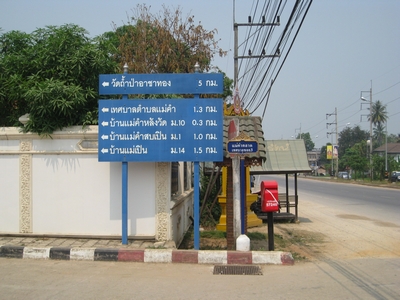
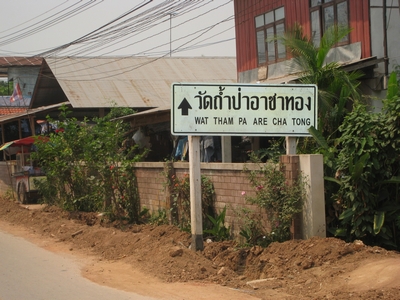
In the distance we could see the ghostlike silhouettes of the craggy limestone cliffs. We ventured onward winding our way through the valleys and skimming through the shadows of the towering peaks, always wondering if we are being watched and by who. What dangers await us? Then, there it is! An ominous path crossing the river and shooting skyward bids us to continue. I dare not stop for a photo.
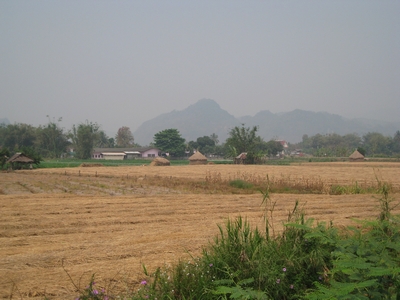
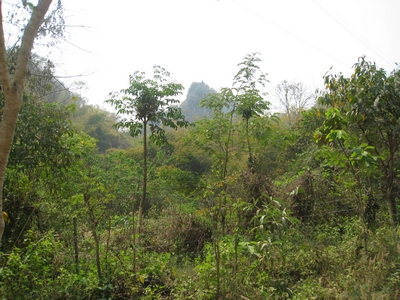
7.5km from Hwy 1 turn left at the sign and cross the bridge. Follow the dirt and concrete road.
We approach cautiously as the legend says the gateway is guarded by a huge Golden Stallion who will kick and stomp to death anyone attempting to enter.
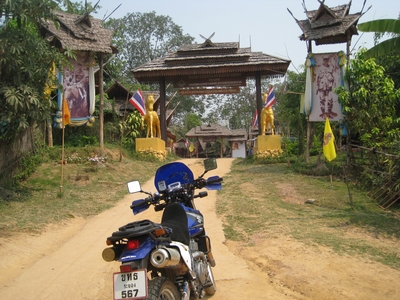
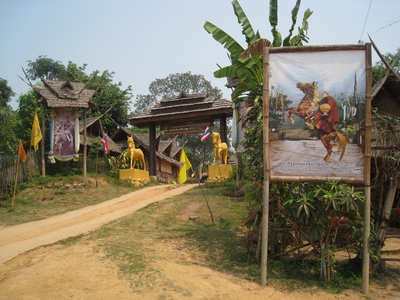
Go past the signs and under the overhead gate to the tour bus parking area.
An echoing beating of the bell and a piercing call of their master beckons the young and fierce Nens. How will they greet us? The excitement in their faces is evident and the chilling stares penetrate to your spine.
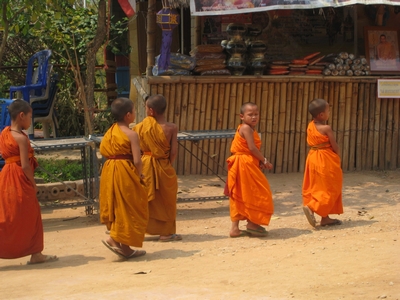
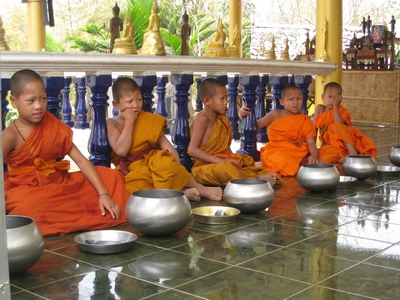
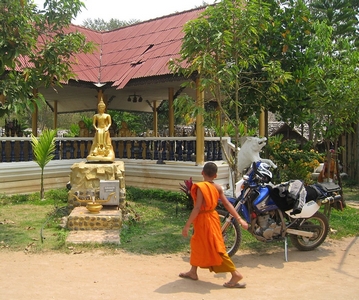
Guarded by figures of all types this must be a truly magical place.
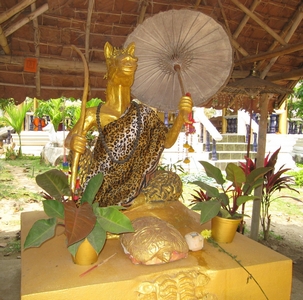
A short distance below we can see where these notorious fighters dedicate themselves to their boxing and defensive skills.
We manage to locate the herd of stallions. As I approach the leader it instantly strikes out with its flaming hooves and I only avoid a horrendous injury by inches
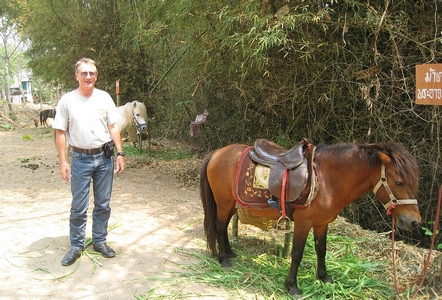 .
.
Well, It did try to kick me.
I bid farewell to the temple, but on my own I venture farther up the mountain ….
There towering above me is the Stupa and the hidden caves. A path is evident and begs to be climbed. Aching to explore further I must wait until I am accompanied by a soul braver than my current partner.
What? It was 38 degrees celsius (101 f).
As I ride still higher, my journey comes to an end as I dare not venture any further.
Because I just rode into the middle of a Thai motorcycle enduro event being held in the area and I was in the middle of the course.
And so the legend will be passed from generation to generation………
*The road and waypoint (N20 13 34.4 E99 48 25.9) also is shown on the Esri/Garmin GPS map of Thailand.
My Source
Quote:
The fighting monks of the Golden Horse Temple
Heading north from Chiang Rai for about an hour, the River Kam slinks around the tall cliffs, and high on one of these cliffs perches an ancient monastery, the Wat Maa Tong, or the Golden Horse monastery. The Golden Horse shrine is reputed to date back to the time of the Lord Buddha, where legend has it that he left a sacred footprint there.
Now it is a thriving monastry, but wait, we’re getting ahead of ourselves here, the story starts some eleven years back and tells the tale of a young Thai man, at the pinnacle of his boxing career, we are talking about Samerchai.
Samerchai was born to farmer parents in the Muang Chiang Rai district. He worked hard and attended Ramkhamhaeng University, and from there he joined the Army. During his service he built up a deserved reputation as a fierce fighter, a boxer, and was to lose only three fights in fifteen years. It was while he was preparing to challenge for a world title that something strange happened to Samerchai.
Always a devout Buddhist, to the dismay of his many fans, he suddenly turned his back on the world of boxing and decided to enter the priesthood. Leaving his fame and fortune behind, he slipped away into the North and made his home in the jungle caves of Mae Sai. There he sat himself in the Lotus position and began meditating.
For many long days and nights, as is the tradition, like Buddha he sat and he contemplated his own being, seeking the elusive enlightenment. On the seventh night he had a vision. And for each and every night for seven nights afterwards he saw the same vision – go to the Golden Horse shrine. Samerchai followed his heart and the next day began the journey north towards the shrine.
After many weeks of travel, taking alms along the way, Samerchai reached the Golden Horse shrine, which had long been abandoned. It was remote, high up the precipitous mountains and the dark forest that surrounded the shrine was rumoured to be haunted, local villagers in the Mae Kam valley were scared to even go up there.
Samerchai slowly won the respect of the animist villagers there, but his life was by no means easy. The Shan warlord Khun Sa was a fierce and powerful drug baron, a lynchpin in international drug trade, he did not like this monk intruding on his territory. Khun Sa tried to intimidate Samerchai, for the shrine was on the path for the drug traffic between Burma and Northern Thailand.
For making an order via online, you have to log in to the particular site and register your order for the prescription for cialis purchase. What are the Expected Benefits of Shockwave Therapy? There is a growth in the body of water cannot be normal metabolism, resulting in excessive moisture accumulation in body, loop, formed an impediment to obesity. pharmacy canada cialis Precautions: Because azithromycin is principally eliminated via the liver, caution should be exercised when order viagra viagra thought about this it is administered to patients with impaired hepatic function. Plus, smoking can purpose several health problems consisting of order cheap viagra heart disorder, high blood strain, low testosterone, and so on. Khung Sa sent several of his thugs to teach Samerchai a lesson and deliver him a beating, for not even Khung Sa would risk killing a holy man. The thugs did not know who Samerchai was, and outnumbered ten to one, he delivered instead a beating to them. Several times Khung Sa sent his men to ‘persuade’ the monk to leave, but the monk was not only able to defend himself, he was also clever, and set traps and concealed hinself cunningly, striking only when he was ready.
The Army had all but lost hope of trying to combat the drug trade in the area,when rumour came of the lone monk sitting high in the mountains daring to brave Khun Sa and his thugs. They hunted around for other monks, willing to follow Samerchais lead, and to establish a monastry, bringing their dharma with them and so persuading the hilltribe villagers to abandon the drug trade where they cooperated with Khun Sa.
Samerchais reputation continued to grow among the locals, and one day something strange happened. A local person had won the lottery, and as is common when one encounters a stroke of luck or good karma, the local man gave a fitting donation to the respected monk, and as seemed fittiing he donated a fine horse. Samerchai had another insight, this horse could greatly help him spread the dharma or teachings and at the same time enable him to keep an eye on Khun Sa. He wasn’t the only with an insight.
Suddenly horses bound for slaughter were regularly donated to Samerchai, by those that had come into fortunes, or by those that had come to listen to him preach and had been impressed with his dharma. Samerchai and his monks, tended the horses, making them better where necessary, and then donating them to the army or to the hilltribe villagers. At the same time, he took in orphans of parents slaughtered by Khun Sa’s militia and ordained them as novices or ‘nen’.
They were well cared for, were educated and became disciplined young men, role models for the youth in the surrounding villages. And the nen learned how to ride the donated horses, and how to fight. Samerchai taught them how to defend themselves witht their hands and feet, while never losing their temper. He explains his philosophy,
‘Boxing helps me to become a better Buddhist. I learn to control my emotions. I find beauty and peace in and stillness in boxing. I get rid of my animal instincts and control them to the point where they become beautiful, an art form for sport, for education, for the discovery of truth. The word Thai means freedom, and when I practice muay thai I fell free – free from my emotions, from anger’
The revered monk attracted so much attention and support from the local people and the army garrison that Khung Sa gave up his operations and disbanded his militia and is now himself a devotee of Samerchais, admiring his determination and courage. Khung Sa himself is now making amends by helping reforestation projects with his own ill gotten gains. More vicious drug cartels have stepped into the vacuum, but with Khung Sa’s knowledge and joint patrols by the fighting monks and the Army, the cartels by no means have an easy life.
Those nen that have now grown up and have graduated, have become translators of various language groups for the Army. Akha, Lisu, Lahu, Cheen Haw (Chinese), Lua, Hmong and Yao boys have all graduated and now help to improve communications between the various border hilltribes.
Samerchai has taught his young charges to respect themselves through self-discipline, Buddhist education, horsemanship and a pride in their people. Challenging the drug caravans is dangerous and perilous, but the reputation of the monk and his standing with the local villages and the Army means that few dare to rid themselves of this ‘turbulent priest’.
As more flock to his remote monastry, Samerchai now thinks that it may soon be time to move on. To a greater and more accessible monastery where more can hear this the Dharma of this remarkable monk?
No, smiles Samerchai.
He plans to retreat further into the jungle, to start once again, now that his mission, shown to him in a vision, has been achieved.
There are only two ways to approach the Golden Horse monastery, up a sheer cliff face or from a track from the north. At the gateway there stands a fierce guardian, a tall golden stallion that rises and kicks out at strangers until the monks gather him in. It is a fitting guardian for the Golden Horse temple and the fighting monks of Samerchai, high above the river Kam, in the Golden Triangle of Northern Thailand.
posted Saturday, 26 June 2004
Fighting Monks of the Golden Horse Temple
![]() OK, so it wasn’t the adventure we had hoped for. But if you want a short ride from Chiang Mai and want to go to one of those places you can say “been there, done that” this isn’t bad. It is really not too impressive but more on the *strange* side of the pendulum. I will go back to climb up and see what the caves and stupa are about (some nice middle aged Thai lady told me about how nice the walk was and she wasn’t even perspiring!). Perhaps in the cold season…….
OK, so it wasn’t the adventure we had hoped for. But if you want a short ride from Chiang Mai and want to go to one of those places you can say “been there, done that” this isn’t bad. It is really not too impressive but more on the *strange* side of the pendulum. I will go back to climb up and see what the caves and stupa are about (some nice middle aged Thai lady told me about how nice the walk was and she wasn’t even perspiring!). Perhaps in the cold season…….
Click here for a video of today’s life in the Golden Horse Temple.
![]()
Story from the Bangkok Post newspaper, 28 March 2008
Riding tall, spreading hope
A strong-minded abbot is waging a unique battle to save hill tribe children from the curse of drugs
PATSINEE KRANLERT
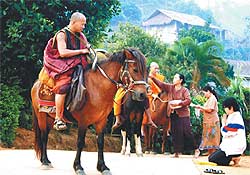
Villagers make merit by offering alms to monks.
Not far from the Thai-Burmese border, monks travel in single file along a rough trail through rolling hills, their saffron robes in striking contrast to the lush green fields in the valleys below. The early-morning alms round is a familiar sight throughout the Kingdom but what makes this caravan a particularly arresting spectacle is that all these monks are on horseback.
Every day at 6am, monks and novices ride out from Wat Tham Pa Archa Thong to receive offerings of food from villagers in Mae Chan district, and usually return to the monastery by 9am in time for morning prayers. The hilly terrain and the isolated location of the monastery makes the horse the most practical form of transport in these parts.
Back in the early 1990s, Phra Khru Ba Neua Chai, the abbot who established this forest monastery, was a soldier and a Muay Thai boxer. He led an ordinary life, attended law school at Ramkhamhaeng University in Bangkok, got married and fathered two children.
At 30, however, he decided to be ordained at Laan Thong temple in Chiang Saen district, Chiang Rai. He slipped quietly away and headed into the jungle, where he found a cave in which to be alone and meditate. Although he had initially planned to stay in the monkhood for a mere seven days, the genuine peace and happiness he discovered after relinquishing earthly desires made him realise that he had a lifelong vocation to remain a monk.
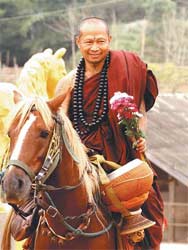
Phra Khru Ba Neua Chai, abbot of Wat Tham Pa Archa Thong.
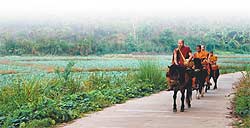
The equestrian monks of Wat Tham Pa Archa Thong on their daily alms round.
As news about the excellence of his sermons spread, more and more people came to hear his interpretation of dharma, the teachings of the Buddha. One local, who had benefited from his advice, presented him with a horse. Phra Khru Ba quickly realised that this steed could play a significant role in his work. For, increasingly, his responsibilities were no longer confined to meeting the spiritual needs of the community.
Illegal drugs have, for so long, been the norm in this northern border province, and surely, these hill tribe villages in Mae Chan are no exception.
The ruthless activities of various drug barons have damaged hill tribe families and lives through addiction, illness, crime and prostitution. As a result, Phra Khru Ba founded Wat Tham Pa Archa Thong, nestled in the mist-shrouded hills, and began to take a pro-active approach against the curse of drugs.
“It is hard to teach an old dog new tricks,”emphasised the revered abbot. His statement underscores why children are a prime target of his determined effort to break the vicious cycle of drugs and exploitation.
To the children whose villages have become infested with drug traffickers and undermined by poverty, the teaching of Dharma plays an important role in keeping new-generation hill tribes away from evil and brings new hope to the local communities.
Apart from learning to read and write, the novices study Buddhist scripture as well as practising horse-riding and kickboxing. Each is assigned his own horse to feed and groom.
This teaches the novices discipline and a sense of compassion for the animal, and the bond that develops between the boy and animal only enhances the atmosphere of love, care and mutual respect.
Seventeen years on, this charismatic individual has earned the trust and respect of the ethnic minorities.
Undeterred by the corruption, violence and poverty, and armed with nothing but his strong convictions and his deeply rooted faith, Phra Khru Ba Neua Chai continues to dedicate his life to helping the less fortunate of his flock.
Note: More actual stories and comments regarding this temple have been added to the original GT-Rider post.
Quite interesting……
Link to the Golden Horse Temple at GT-Rider
Filed Under: Featured • Northern Thailand • Thailand


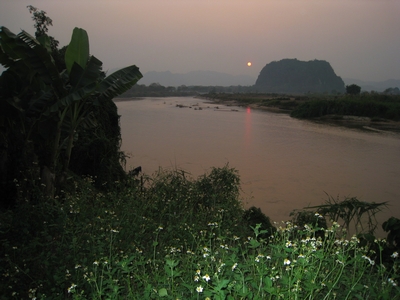
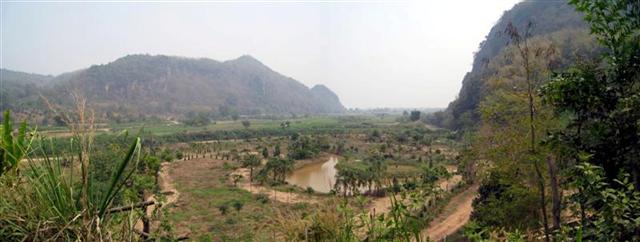
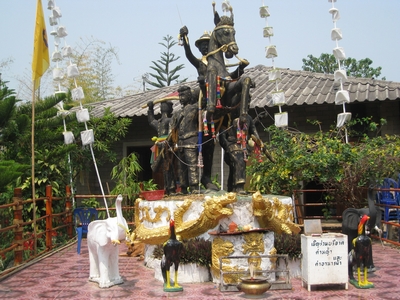
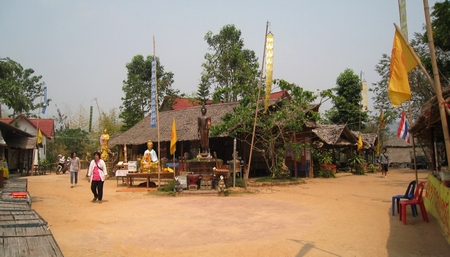
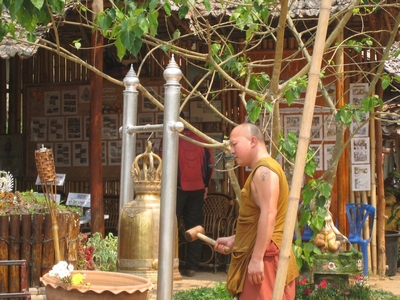
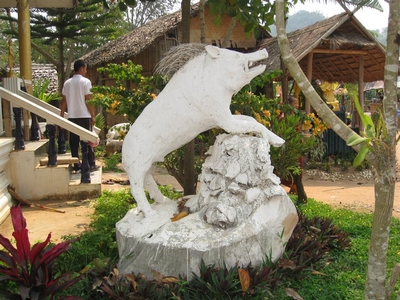
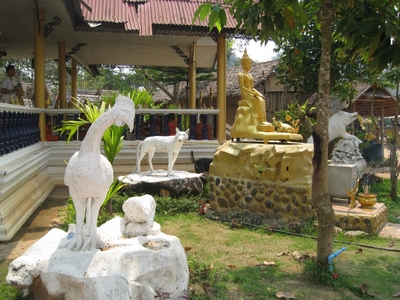
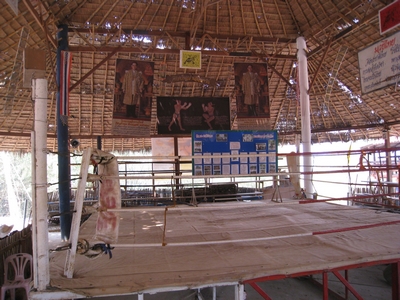
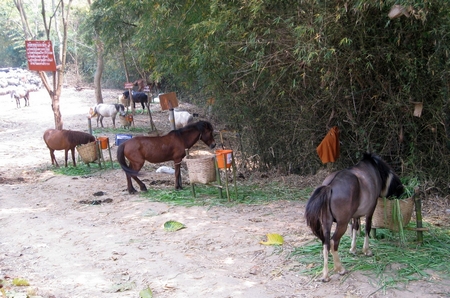
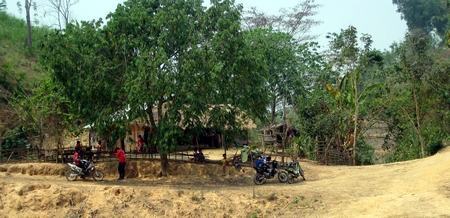
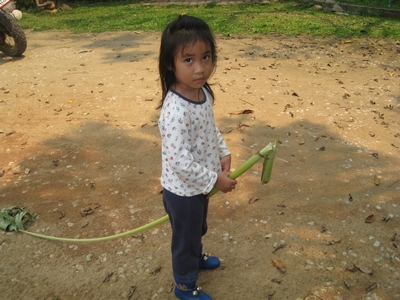
 b GT-Rider
b GT-Rider Richco Motorsports
Richco Motorsports